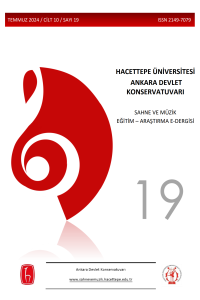REVIEW OF SIDIKA ÖZDİL’S WORK CALLED “FACING PHASELIS” IN TERMS OF WRITING TECHNIQUES AND ITS CONTRIBUTIONS
Öz
With the development of their musical sense, composers began to use non-traditional notation styles in their pieces and expanded the traditional musical language since the beginning of the 20th century. This new musical language has been tried periodically in Turkey. One of the important representatives of this new movement, Sıdıka Özdil has made significant progress with her composition titled "Facing Phaselis". Facing Phaselis is the first Turkish composition made an entry in the Royal Opera House Library. In this study, Turkish Composer Sıdıka Özdil's work titled "Facing Phaselis", commissioned by the Royal Opera House for the Royal Opera House soloists, is examined. “Facing Phaselis” which is written for ten string instruments, was analyzed by breaking it down into parts in terms of the original techniques it contains. This analysis covers the techniques, notation changes and technical creations within. During the analysis, the order of the work's rehearsal signs (A, B, etc.) was followed. The analysis presents the modern-traditional synthesis and original techniques of the work, which are aimed to inspire young composers.
Anahtar Kelimeler
Kaynakça
- Hodeir, Andre (2011). Müzikte Türler ve Biçimler (İlhan Usmanbaş. Çev.). İstanbul. Pan Yayıncılık
- Kent, Kennan (1999). Counterpoint. London. Prentice Hall International (UK) Limited.
- Macpherson, Stewart (2006). Form in Music. Claremont. Pomona Press
- Özdil, Sıdıka (1978). Necil Kâzım Akses’in el yazması notları
- Paul Patterson.Erişim:26.04.2024, http://paulpatterson.co.uk
- Royal Opera House.Erişim.26.04.2024, https://www.roh.org.uk/about/the-royal-opera/history
- Sadie, Stanley (1995). The New Grove. Stanley, Sadie. The New Grove Dictionary of Music and Musicians(Volume 7 s. 9-21). London. Macmillian Publishers Limited.
- Say, Ahmet (2010). Ankara. Müzik Ansiklopedisi (3 cilt). Müzik Ansiklospedisi Yayınları
- Say, Ahmet (2015). Ankara. Müzik Tarihi. Müzik Ansiklopedisi Yayınları
- Sevsay, Ertuğrul (2012). Orkestrasyon. İstanbul. Yapı Kredi Yayınları
- Schott Music Group.Erişim:26.04.2024, https://www.schott-music.com/en/
- Solomon, Samuel Z. (2006). How to Write for Percussion. New York. SZSolomon.
- Soysal, İlhami (1997). 20. Yüzyıl Türk Şiiri Antolojisi. Ankara. Bilgi Yayınevi
- Stein, Leon (1979). Structure & Style. Miami. Summy – Birchard Inc.
- Stone, Kurt (1980). Music Notation in the Twentieth Century. London W.W. Norton & Company.
- Usmanbaş, İlhan (1974). Müzikte Biçimler. İstanbul. Milli Eğitim Basımevi
- Yavuz, Elif Damla (2013). Hindemith Raporları. Ankara. SCA Müzik Vakfı Yayınları
- Yılmaz, Vecihe Cansu (2017). Paul Patterson’un Op. 1 Rebecca Adlı Eserinin Bestecilik Teknikleri Açısından İncelenmesi. (Sanat Çalışması Raporu) Hacettepe Üniversitesi Ankara Devlet Konservatuvarı. Ankara.
SIDIKA ÖZDİL’İN “FASELİS İLE YÜZLEŞME” (FACING PHASELIS) ADLI ESERİNİN, YAZILIŞ ŞEKLİ BAKIMINDAN İNCELENMESİ VE LİTERATÜRE KATKILARI
Öz
20’inci yüzyılın başından itibaren besteciler, müzikâl duyuşlarının gelişmesiyle eserlerinde geleneksel olmayan nota yazım şekillerini de kullanmaya başlamış ve geleneksel müzik dilini genişletmişlerdir. Söz konusu bu yeni müzik dili Türkiye’de belli aralıklarla denenmiştir. Yeni müzik dilini kullanan ve bu yeni akımın önemli temsilcilerinden olan Sıdıka Özdil, bestelediği “Faselis ile Yüzleşme” adlı eseriyle önemli bir ilerleme kaydetmiştir. Bu eser, Royal Opera House Kütüphanesi’ne giren ilk Türk eseri olma niteliğini taşır. Bu çalışmada Türk Besteci Sıdıka Özdil’in Royal Opera House tarafından, Royal Opera House solistleri için ısmarlanan “Faselis ile Yüzleşme” adlı eseri konu alınmıştır. 10 yaylı çalgı için yazılmış “Faselis ile Yüzleşme” (Facing Phaselis), içeriğinde bulunan özgün teknikler açısından parçalara ayrılarak analiz edilmiştir. Bu analiz eserin akışının oluşturduğu sürece dair olup; içerisindeki teknikleri, notasyon değişimlerini ve teknik yaratımları kapsamaktadır. Analiz esnasında eserin prova işaretlerinin (A, B vb.) sırası izlenmiştir. Ortaya konan analizle eserin modern-geleneksel sentezinin ve özgün tekniklerinin, genç bestecilere ilham vermesi hedeflenmiştir.
Anahtar Kelimeler
Kaynakça
- Hodeir, Andre (2011). Müzikte Türler ve Biçimler (İlhan Usmanbaş. Çev.). İstanbul. Pan Yayıncılık
- Kent, Kennan (1999). Counterpoint. London. Prentice Hall International (UK) Limited.
- Macpherson, Stewart (2006). Form in Music. Claremont. Pomona Press
- Özdil, Sıdıka (1978). Necil Kâzım Akses’in el yazması notları
- Paul Patterson.Erişim:26.04.2024, http://paulpatterson.co.uk
- Royal Opera House.Erişim.26.04.2024, https://www.roh.org.uk/about/the-royal-opera/history
- Sadie, Stanley (1995). The New Grove. Stanley, Sadie. The New Grove Dictionary of Music and Musicians(Volume 7 s. 9-21). London. Macmillian Publishers Limited.
- Say, Ahmet (2010). Ankara. Müzik Ansiklopedisi (3 cilt). Müzik Ansiklospedisi Yayınları
- Say, Ahmet (2015). Ankara. Müzik Tarihi. Müzik Ansiklopedisi Yayınları
- Sevsay, Ertuğrul (2012). Orkestrasyon. İstanbul. Yapı Kredi Yayınları
- Schott Music Group.Erişim:26.04.2024, https://www.schott-music.com/en/
- Solomon, Samuel Z. (2006). How to Write for Percussion. New York. SZSolomon.
- Soysal, İlhami (1997). 20. Yüzyıl Türk Şiiri Antolojisi. Ankara. Bilgi Yayınevi
- Stein, Leon (1979). Structure & Style. Miami. Summy – Birchard Inc.
- Stone, Kurt (1980). Music Notation in the Twentieth Century. London W.W. Norton & Company.
- Usmanbaş, İlhan (1974). Müzikte Biçimler. İstanbul. Milli Eğitim Basımevi
- Yavuz, Elif Damla (2013). Hindemith Raporları. Ankara. SCA Müzik Vakfı Yayınları
- Yılmaz, Vecihe Cansu (2017). Paul Patterson’un Op. 1 Rebecca Adlı Eserinin Bestecilik Teknikleri Açısından İncelenmesi. (Sanat Çalışması Raporu) Hacettepe Üniversitesi Ankara Devlet Konservatuvarı. Ankara.
Ayrıntılar
| Birincil Dil | Türkçe |
|---|---|
| Konular | Klasik Batı Müziğinde Kompozisyon |
| Bölüm | Makaleler |
| Yazarlar | |
| Yayımlanma Tarihi | 20 Temmuz 2024 |
| Gönderilme Tarihi | 8 Mayıs 2024 |
| Kabul Tarihi | 18 Temmuz 2024 |
| Yayımlandığı Sayı | Yıl 2024 Cilt: 10 Sayı: 19 |


